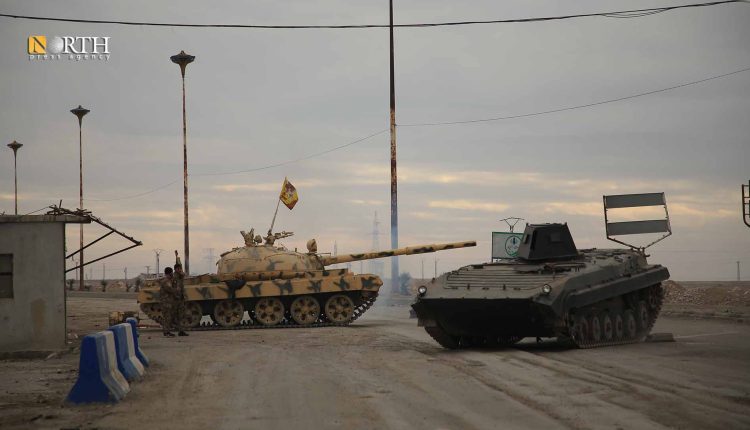
By Abdulsalam Khoja
QAMISHLI, Syria (North Press) – Experts on terrorism warn that the Islamic State (ISIS) is making a troubling comeback in Syria, with a notable uptick in its military activity in recent weeks, particularly in Deir ez-Zor in eastern Syria and the outskirts of the Syrian Desert.
They point out that this resurgence has come in the wake of the collapse of the previous Syrian regime on Dec. 8, 2024, which enabled ISIS to seize large quantities of weapons and ammunition, facilitating its reorganization and the launch of new attacks.
They caution that this activity is “neither sudden nor temporary,” but rather a sign of a new phase in the group’s operations—one fueled by a fragile security environment, deteriorating humanitarian conditions, and the absence of stability.
ISIS activity on the rise
Zana Omar, a journalist from Qamishli in northeastern Syria and an expert on terrorism, says the collapse of the former regime allowed ISIS to take control of significant caches of arms and ammunition.
He told North Press, “The Syrian arena is witnessing a renewed surge in ISIS activity, marking a worrying return of the group at a critical moment, driven by several overlapping factors—chief among them, the massive security vacuum following the regime’s collapse and ISIS’s subsequent access to weapon stockpiles.”
He added that Turkish attacks on the Syrian Democratic Forces (SDF) have eased pressure on ISIS cells. With the SDF preoccupied with defending its areas, the group has been able to reposition itself and transfer militants from the desert to areas east of the Euphrates, he pointed out.
Omar continued, “The uptick in ISIS operations coincides with reports of U.S. forces repositioning or partially withdrawing from northeastern Syria, including the evacuation of certain bases in Deir ez-Zor—an area now experiencing the most intense ISIS attacks in years.”
He noted that indicators suggest these attacks will likely escalate in the near future, both in terms of targets and tactics, with a clear shift from isolated strikes to coordinated group operations.
SDF Commander in Chief, Mazloum Abdi, warned, following the fall of Bashar al-Assad’s regime, that the threat of ISIS in detention centers and camps is growing, and overall ISIS activity is increasing.
Abdi pointed out at the time that there is a pressing need to intensify efforts to continue the fight against ISIS to prevent its resurgence, adding that approximately 10,000 ISIS fighters remain in prison, ready to reignite chaos in the Middle East.
Human factor
Zana Omar also pointed to growing signs that ISIS is expanding its recruitment capabilities, taking advantage of two pivotal developments. “First, the war in Gaza, which has bolstered jihadist narratives, and second, discontent among many jihadists with the policies of Hayat Tahrir al-Sham (HTS), leading some to defect and pledge allegiance to ISIS.”
He added that ISIS’s short-term objectives include taking control of prisons and the Hawl and Roj camps by strengthening its influence in Deir ez-Zor in preparation to expand its territorial control.
It is also expected that the group might attempt a repeat of the notorious prison break in Hasakah, using suicide and infiltration attacks, he added.
Omar noted that “Everything we are witnessing now may be just the beginning of a more complex and dangerous phase. There is a real risk of a broader security collapse in Syria and Iraq—whether through intensified ISIS attacks or the emergence of a new jihadist group splintered from HTS due to deep ideological and organizational rifts aligned with ISIS’s vision.”
Golden opportunity
Lamar Arkandi, a journalist specializing in terrorism affairs, said that ISIS has significantly regained strength, showing renewed activity and an increased ability to recruit new fighters.
Speaking to North Press, she explained, “ISIS’s resurgence is due to multiple factors, including the security vacuum created by Assad’s flight and the U.S. decision to reduce its military presence in Deir ez-Zor—an area ISIS considers its former capital and core territory, lost in 2019.”
Arkandi, who is based in Qamishli, added, “The group found a golden opportunity to reorganize and launch operations in new areas, especially with the return of many displaced people to the desert outskirts, where they face dire economic conditions and a complete lack of infrastructure—making them easy targets for recruitment.”
She noted that after the fall of the so-called caliphate in Baghuz at the hands of the SDF, hundreds of ISIS fighters fled to Idlib and other areas under Turkish control and joined local armed factions.
She continued that the group is now calling on its fighters—who had joined other factions—to defect and return to its ranks. It is also working to free ISIS prisoners held by the SDF, aided by Uyghur fighters who have carried out attacks in places like al-Rai and Idlib.
The Kurdish journalist does not rule out the possibility that ISIS will use advanced weaponry in its upcoming operations, including drones and various types of missiles, obtained from abandoned Iranian-backed militia stockpiles after their withdrawal from Syria.
“We may soon see ISIS deploying more lethal weapons than those used in its previous operations in the Syrian Desert,” she warned.
